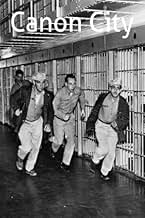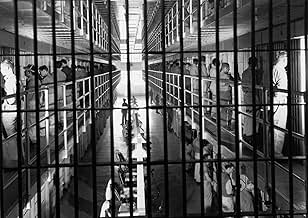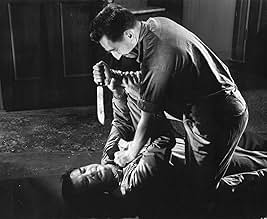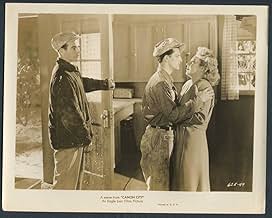Ajouter une intrigue dans votre langueTwelve inmates plan a prison break from the Colorado State Penitentiary but one of them reluctantly joins the group.Twelve inmates plan a prison break from the Colorado State Penitentiary but one of them reluctantly joins the group.Twelve inmates plan a prison break from the Colorado State Penitentiary but one of them reluctantly joins the group.
- Réalisation
- Scénario
- Casting principal
Reed Hadley
- Narrator
- (voix)
Avis à la une
Noirish docu-drama based on 1947 Colorado State Prison break.
The movie's best parts are the location shots in and around the Colorado State Pen. We get at least a flavor of prison routines and the small town atmosphere. At the same time, the chase sequence at the Royal Gorge provides a scenic, if fictionalized, passage. Then too, ace photographer Alton's studio recreation of the actual winter-time blizzard lends good noirish atmosphere. There's also some tension around convict Schwartzmiller's home invasion; otherwise, the movie's a pretty routine slice of thick ear.
To me, the screenplay surrounding the break and its aftermath seems muddled. Scenes follow in no particular developmental order. Characters are glimpsed and then dropped. It may be that writer Wilbur felt constrained by the film's factual basis and hurry-up schedule. After all, the movie wrap-up came only four months (January-May) after the breakout itself. (Contrast this rather disjointed narrative with the streamlined smoothness of the fictional, albeit thematically similar, Crashout {1955}.)
As a youngster growing up a few miles from Canon City, I still have a recollection of the hubbub surrounding the breakout. The name Sherbondi suddenly became a household alarm, though I'm not sure he was the sympathetic character of the screenplay. Guns abruptly sprouted across the Arkansas (river) Valley like deer season. Speaking of those memorable few days, I'm glad the movie re-creates the blizzard that certainly hampered the getaway. That rural part of the state seldom made Denver news, let alone national headlines. So it was a pretty big deal for us living there. (In passing--- Warden Roy Best, featured in the movie, later suffered big professional damage when his liberal use of a whipping post for unruly prisoners got statewide exposure.)
Choppy narrative and personal recollections aside, the film remains an interesting example of noirish docu-drama, which the results here strongly resemble.
The movie's best parts are the location shots in and around the Colorado State Pen. We get at least a flavor of prison routines and the small town atmosphere. At the same time, the chase sequence at the Royal Gorge provides a scenic, if fictionalized, passage. Then too, ace photographer Alton's studio recreation of the actual winter-time blizzard lends good noirish atmosphere. There's also some tension around convict Schwartzmiller's home invasion; otherwise, the movie's a pretty routine slice of thick ear.
To me, the screenplay surrounding the break and its aftermath seems muddled. Scenes follow in no particular developmental order. Characters are glimpsed and then dropped. It may be that writer Wilbur felt constrained by the film's factual basis and hurry-up schedule. After all, the movie wrap-up came only four months (January-May) after the breakout itself. (Contrast this rather disjointed narrative with the streamlined smoothness of the fictional, albeit thematically similar, Crashout {1955}.)
As a youngster growing up a few miles from Canon City, I still have a recollection of the hubbub surrounding the breakout. The name Sherbondi suddenly became a household alarm, though I'm not sure he was the sympathetic character of the screenplay. Guns abruptly sprouted across the Arkansas (river) Valley like deer season. Speaking of those memorable few days, I'm glad the movie re-creates the blizzard that certainly hampered the getaway. That rural part of the state seldom made Denver news, let alone national headlines. So it was a pretty big deal for us living there. (In passing--- Warden Roy Best, featured in the movie, later suffered big professional damage when his liberal use of a whipping post for unruly prisoners got statewide exposure.)
Choppy narrative and personal recollections aside, the film remains an interesting example of noirish docu-drama, which the results here strongly resemble.
Filmed With The Naked Fury Of Fact! So screams the poster for this semi-documentary styled pic. Barely a year previously a dozen prisoners escaped from the Colorado State Penitentiary, Canon City, this is the story of that break and subsequent hunt for the escapees.
Written and directed by Crane Wilbur, it stars Scott Brady, Jeff Corey and Whit Bissell. Cinematography is by John Alton and Reed Hadley provides the stentorian narration. Plot is exactly what it says on the cover, men escape prison and as a blizzard rages outside they encounter various members of the public whilst trying to escape capture.
The various convict character splinters, as we follow the principal escapees, makes for suspenseful scenes as they impose themselves on the homes of good honest folk. The moral dilemma heartbeat comes via Brady's Jim Sherbondy, a man who was reluctant to escape but ultimately got caught up in the whirlpool. The characterisations are standard for this type of picture, but well performed all the same, with Corey particularly striking as a weasel type. The various women in the story are well written, proving to be of strong will and minds, while Alton and Wilbur enhance the fatalistic mood with low lights and close ups.
A decent pic from the pantheon of prison noir, but not a patch on the likes of Brute Force and Riot In Cell Block 11. 6/10
Written and directed by Crane Wilbur, it stars Scott Brady, Jeff Corey and Whit Bissell. Cinematography is by John Alton and Reed Hadley provides the stentorian narration. Plot is exactly what it says on the cover, men escape prison and as a blizzard rages outside they encounter various members of the public whilst trying to escape capture.
The various convict character splinters, as we follow the principal escapees, makes for suspenseful scenes as they impose themselves on the homes of good honest folk. The moral dilemma heartbeat comes via Brady's Jim Sherbondy, a man who was reluctant to escape but ultimately got caught up in the whirlpool. The characterisations are standard for this type of picture, but well performed all the same, with Corey particularly striking as a weasel type. The various women in the story are well written, proving to be of strong will and minds, while Alton and Wilbur enhance the fatalistic mood with low lights and close ups.
A decent pic from the pantheon of prison noir, but not a patch on the likes of Brute Force and Riot In Cell Block 11. 6/10
A fine prison break movie from Crane Wilbur by way of Eagle-Lion Pictures, Canon City is a very good, tense film, based on a true incident, about a group of men who break of of the eponymous state prison, where the movie was also filmed. There is particular emphasis on two escapees, a reluctant one who is basically a decent guy, and a more aggressive one, who isn't. As portrayed by Scott Brady and Jeff Corey these characters come to life and compel our interest, and in Brady's case sympathy.
As photographed by the masterful John Alton, the picture is a pleasure to watch, as Mr. Alton was a master of light and shadow, and is obviously in his element with this dark story. He brightens things up in the end with a snowstorm, which enables the picture to end on a grace note, and even a feeling of optimism, not wholly justified by the events we have just witnessed.
As photographed by the masterful John Alton, the picture is a pleasure to watch, as Mr. Alton was a master of light and shadow, and is obviously in his element with this dark story. He brightens things up in the end with a snowstorm, which enables the picture to end on a grace note, and even a feeling of optimism, not wholly justified by the events we have just witnessed.
Canon City (1948)
A simple loud warning up front--the first twenty minutes or so is a horrible, stiff, documentary kind of lead-in to the movie proper. When the dramatic action gets going, it becomes fully a movie with suspense, character, speed, and even at times complexity. In fact, you could even fast forward to where you see the buy in the jail cell doing a model of a ship.
The stuff before that is not needed. It tells us what we already know about prison, though it seems to use real inmates in brief interviews, as if to set up the later jailbreak as something more tangible and believable.
It isn't giving anything away to say that some inmates escape--that's the whole hook of the movie--and then what happens to each group or individual in their attempts to get out of Canon City is what drives the movie in a series of somewhat independent vignettes. The encounters with regular town people in their homes is a little contrived but also has the edge of fear to it, and suspense. It works pretty well, the cops gradually closing in on this or that escapee.
The end result is still almost a public relations piece about the prison system, about ordinary Americans who rise up and do heroic things, and about the different kinds of attitudes of the inmates, who are people after all. I actually liked the second half of the movie, even it it wasn't completely original or brilliant. The acting is meant to be believable in a vernacular kind of way, and it is. Give it a look, especially if you like prison flicks.
A simple loud warning up front--the first twenty minutes or so is a horrible, stiff, documentary kind of lead-in to the movie proper. When the dramatic action gets going, it becomes fully a movie with suspense, character, speed, and even at times complexity. In fact, you could even fast forward to where you see the buy in the jail cell doing a model of a ship.
The stuff before that is not needed. It tells us what we already know about prison, though it seems to use real inmates in brief interviews, as if to set up the later jailbreak as something more tangible and believable.
It isn't giving anything away to say that some inmates escape--that's the whole hook of the movie--and then what happens to each group or individual in their attempts to get out of Canon City is what drives the movie in a series of somewhat independent vignettes. The encounters with regular town people in their homes is a little contrived but also has the edge of fear to it, and suspense. It works pretty well, the cops gradually closing in on this or that escapee.
The end result is still almost a public relations piece about the prison system, about ordinary Americans who rise up and do heroic things, and about the different kinds of attitudes of the inmates, who are people after all. I actually liked the second half of the movie, even it it wasn't completely original or brilliant. The acting is meant to be believable in a vernacular kind of way, and it is. Give it a look, especially if you like prison flicks.
"Canon City" (spelled c-a-n-o-n but pronounced as "canyon") is an example of a type of film prominent in the late 1940s: the docudrama. Usually these films had a noirish sensibility and were almost always about gritty subject matter. They were part documentary and part fiction -- filmed on location in actual locales with objective third-party narration, stripped-down production values and a journalistic focus on presenting events matter-of-factly and without superfluous emotion.
"Canon City" tells the story of a famous prison break from a Colorado penitentiary. The first part of the film gives us a tour of the prison and introduces us to men who were the actual inmates at the time the movie was filmed; the chief warden of the prison likewise plays the warden in the movie. After this extended prologue, actors take over to portray the actual escape and the subsequent manhunt that put families living nearby at risk as the escaped cons used their homes as hideouts.
The film is very spare and terse, which is not a criticism from me. It's a refreshing break from the Hollywood melodrama that characterized glossier, studio-backed movies at the time. But the film is SO bare bones that it's difficult to feel strongly one way or the other about it. Its bargain-bin look is a nice compliment to the story it's telling, but one can't help but miss the style that artists who came with a higher price tag might have brought to the same material.
Grade: B
"Canon City" tells the story of a famous prison break from a Colorado penitentiary. The first part of the film gives us a tour of the prison and introduces us to men who were the actual inmates at the time the movie was filmed; the chief warden of the prison likewise plays the warden in the movie. After this extended prologue, actors take over to portray the actual escape and the subsequent manhunt that put families living nearby at risk as the escaped cons used their homes as hideouts.
The film is very spare and terse, which is not a criticism from me. It's a refreshing break from the Hollywood melodrama that characterized glossier, studio-backed movies at the time. But the film is SO bare bones that it's difficult to feel strongly one way or the other about it. Its bargain-bin look is a nice compliment to the story it's telling, but one can't help but miss the style that artists who came with a higher price tag might have brought to the same material.
Grade: B
Le saviez-vous
- AnecdotesFilm debut of Scott Brady.
- GaffesImmediately after the prison break, there's a shot of a crowd of people leaving a movie theatre, with Abbott & Costello in 36 heures à vivre (1948) (another Eagle-Lion release) prominently displayed on the readerboard. Only problem is, the break took place 30 December 1947, and The Noose Hangs High wasn't released until the end of the following April.
- ConnexionsReferenced in Let's Go to the Movies (1949)
Meilleurs choix
Connectez-vous pour évaluer et suivre la liste de favoris afin de recevoir des recommandations personnalisées
Détails
Box-office
- Budget
- 424 000 $US (estimé)
- Durée1 heure 22 minutes
- Couleur
- Rapport de forme
- 1.37 : 1
Contribuer à cette page
Suggérer une modification ou ajouter du contenu manquant

Lacune principale
By what name was Pénitencier du Colorado (1948) officially released in India in English?
Répondre

































